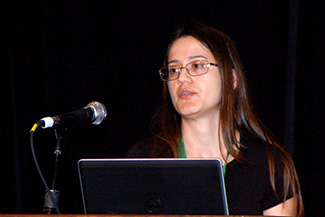The Promise of Genomics
Expectations for the benefits of genomics in genetic selection are being realized.
by Troy Smith for Angus Media
They promised a doubling of the accuracy of prediction for genetic merit. Looking back, it’s easy to see that some early advocates of genomics were somewhat overzealous in promoting a still underdeveloped technology. Yet after getting off to a slow start, the science has advanced remarkably, and many of the early promises of genomics for improving genetic selection are being realized.

University of Georgia geneticist Daniela Lourenco
University of Georgia geneticist Daniela Lourenco recounted the history of genomics, as applied to selection of breeding animals, from early investigation of DNA to the latest method for calculating genomic-enhanced expected progeny difference (GE-EPD) values. She spoke during the first general session of the Beef Improvement Federation (BIF) Annual Meeting and Symposium hosted May 31-June 3 in Athens, Ga.
While livestock DNA studies began in the late 1970s and early 1980s, it was the human genome project that revealed some of the most valuable information. More specifically, according to Lourenco, it was information explaining that much genome sequence variation can be attributed to single-nucleotide polymorphisms (SNP). SNPs became important as markers for genes strongly associated with specific traits, and application of marker-assisted selection. However, the application for cattle breeding was limited.
“It did not work really well, because most traits of interest are polygenetic, meaning they are influenced by multiple genes, with each having a small effect,” explained Lourenco.
It was in 2009, she explained, that the 50,000 SNP genotyping assay became available. By the end of that year, the dairy industry had genotyped some 30,000 animals. The American Angus Association was the first to embrace genomics as the beef industry initiated genotyping.
“The availability of more genotyped cattle drove the development of new methods to incorporate genomic information into national cattle evaluations,” explained Lourenco. “The first method was called multi-step and, as the name implied, this method required multiple analyses to arrive at the final GE- EPDs. Distinct training and validation populations were needed to develop molecular breeding values (MBVs), which were blended with traditional EPDs or included as correlated traits.”
Now, according to Lourenco, there is an alternative single-step method that combines phenotypes, pedigrees and genotypes in a single step offering a better estimation of relationships and greater accuracies.
Lourenco said genomic-enhanced EPDs are delivering the promises of increased accuracy of prediction on younger animals, allowing for reduced generational interval. Genomics also aid prediction for animals with no progeny and aid selection for traits that are hard to measure or are of low heritability.
While early promoters of genomics promised too much too soon, their expectations for the technology were mostly just premature, she emphasized. They were not off the mark.
Editor’s Note: This summary was written under contract or by staff of Angus Media. Through an agreement with the Beef Improvement Federation, we are encouraging reprinting of the articles to those who will adhere to the reprint guidelines available on this site. Please review those guidelines or contact Shauna Rose Hermel, editor, at 816-383-5270. PowerPoints are posted with permission of the presenter and may not be reproduced in whole or in part without the express permission of the presenter.
Angus Media’s coverage of the event is made possible through collaboration with BIF. For questions about this site, or to notify us of broken links, click here. Look for additional coverage in the Angus Journal, the Angus Beef Bulletin, the Angus Journal Daily, the Angus Beef Bulletin EXTRA and Angus TV.


